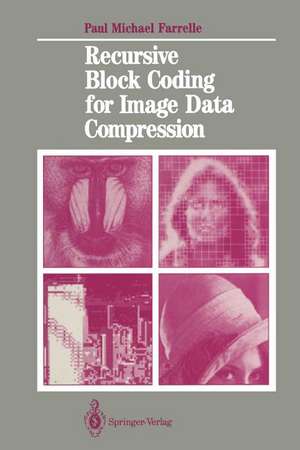Recursive Block Coding for Image Data Compression
Autor Paul M. Farrelleen Limba Engleză Paperback – dec 2011
Preț: 646.95 lei
Preț vechi: 808.69 lei
-20% Nou
Puncte Express: 970
Preț estimativ în valută:
123.79€ • 129.60$ • 102.43£
123.79€ • 129.60$ • 102.43£
Carte tipărită la comandă
Livrare economică 05-19 aprilie
Preluare comenzi: 021 569.72.76
Specificații
ISBN-13: 9781461396789
ISBN-10: 1461396786
Pagini: 328
Ilustrații: XXVIII, 297 p.
Dimensiuni: 155 x 235 x 17 mm
Greutate: 0.46 kg
Ediția:Softcover reprint of the original 1st ed. 1990
Editura: Springer
Colecția Springer
Locul publicării:New York, NY, United States
ISBN-10: 1461396786
Pagini: 328
Ilustrații: XXVIII, 297 p.
Dimensiuni: 155 x 235 x 17 mm
Greutate: 0.46 kg
Ediția:Softcover reprint of the original 1st ed. 1990
Editura: Springer
Colecția Springer
Locul publicării:New York, NY, United States
Public țintă
ResearchCuprins
1 Introduction.- 1.1 The Need for Data Compression.- 1.2 Data Compression Techniques.- 1.3 The Problem—the Tile Effect.- 1.4 Our Approach—Two Source Decomposition.- 1.5 Organization.- 2 RBC—The Theory behind the Algorithms.- 2.1 Introduction.- 2.2 Modeling.- 2.3 Autoregressive Models.- 2.4 Noncausal Models.- 2.5 Two Source Decomposition.- 2.6 The 1d RBC Algorithm.- 2.7 Boundary Response for First Order AR Models.- 2.8 2d Minimum Variance Models.- 2.9 Examples of 2d Noncausal Image Models.- 2.10 2d Boundary Response via Transform Methods.- 2.11 The 2d RBC Algorithm.- 2.12 Approximate Boundary Response.- 2.13 Advantages of RBC.- 3 Bit Allocation and Quantization for Transform Coding.- 3.1 Introduction.- 3.2 Choice of Transform and Quantizer.- 3.3 Bit Allocation.- 3.4 Integer Bit Allocation.- 3.5 Zero Level Quantizers.- 3.6 Choice of RD Function for Bit Allocation.- 3.7 RBC Rate Distortion Analysis.- 3.8 Ensemble Design for DCT and RBC.- 3.9 Color Coding.- 4 Zonal Coding.- 4.1 Introduction.- 4.2 Original Images.- 4.3 Simulation Facilities.- 4.4 Image Quality Measures.- 4.5 1d Coding Results.- 4.6 2d Coding Results.- 4.7 Hybrid Coding.- 4.8 Conclusions.- 5 Adaptive Coding Based on Activity Classes.- 5.1 Introduction.- 5.2 Adaptive DCT.- 5.3 Adaptive RBC.- 5.4 Coding Results.- 5.5 Conclusions.- 6 Adaptive Coding Based on Quad Tree Segmentation.- 6.1 Introduction.- 6.2 Adaptive Segmentation.- 6.3 The Quad Tree Approach.- 6.4 Coding the Segmentation.- 6.5 Reconstruction.- 6.6 Coding the Residual.- 6.7 Results.- 6.8 Conclusions.- 7 QVQ—Vector Quantization of the Quad Tree Residual.- 7.1 Introduction.- 7.2 Vector Quantization.- 7.3 Differential and Interpolate VQ.- 7.4 VQ of the Quad Tree Residual.- 7.5 Coding Results.- 7.6 Conclusions.- 8 Conclusions.- 8.1Introduction.- 8.2 New Results.- 8.3 Coding Recommendations.- 8.4 Future Work.- Appendix A Ordinary and Partial Differential and Difference Equations.- A.1 Introduction.- A.2 Second Order Ordinary Differential Equations.- A.3 Second Order Ordinary Difference Equations.- A.4 Second Order Partial Differential Equations.- A.5 Second Order Partial Difference Equations.- Appendix B Properties of the Discrete Sine Transform.- B.1 Introduction.- Definition.- Notation.- Tridiagonal Toeplitz Matrices.- B.2 DST Evaluation Technique.- B.3 Exponential Sequences.- B.4 Constant Sequences.- B.5 Linear Sequences.- B.6 Hyperbolic Sequences.- B.7 Sinusoidal Sequences.- Appendix C Transform Domain Variance Distributions.- C.1 Introduction.- C.2 1d RBC.- Normalized Variance Distribution.- Variance Reduction Ratio.- C.3 1d DCT.- Appendix D Coding Parameters for Adaptive Coding Based on Activity Classes.- D.1 Introduction.- D.2 Adaptive DCT Coding Parameters.- D.3 Adaptive RBC Coding Parameters.- References.






